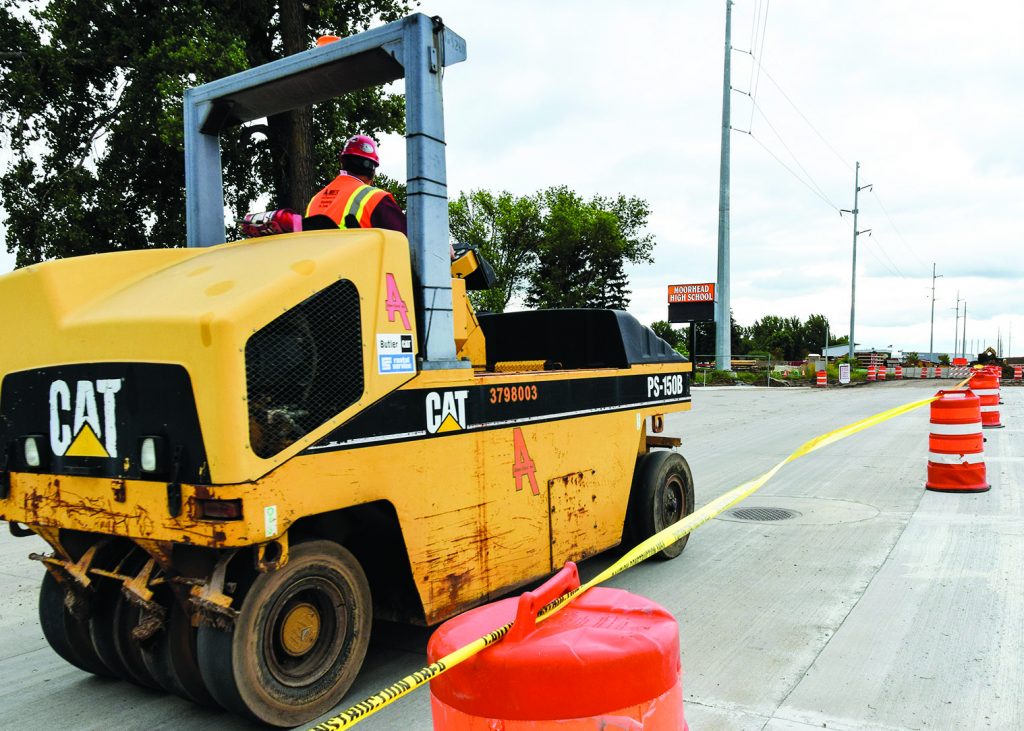
The stretch of 21st Street from Main to Moorhead High School opens this week, just in time for the first day of school. The intersection at 21st and Second Avenue South will help alleviate traffic snarls, especially when school lets out. (Photo/Russ Hanson)
Nancy Edmonds Hanson
hansonnanc@gmail.com
The largest construction project in city history has completed one small milestone that will have big benefits when school opens Tuesday: Access has been restored to the west side of Moorhead High, thanks to completion this week of 21st Street between First and Second Avenues South.
That means buses and cars will be able to once again access the parking lots on the school’s north side from Main Avenue. Opening the intersection should alleviate the traffic jams caused by buses and automobiles exiting the school – a persistent headache when school dismissed last spring. Meanwhile, the detour from 34th Street South via Fourth Avenue, which has been the principle access point since last spring, remains a convenient alternative.
Assistant city engineer Tom Trowbridge says pouring the single block of concrete from First to Second Avenues “took three times longer than it would have,” he explains, because the roadway had to remain open to two-way traffic for access to Casey’s General Store. That meant paving it in three stages.
The engineering department had more good news for homeowners on the west side of the massive project. As of this Tuesday, Trowbridge was projecting that the intersection of Sixth Avenue and 20st Street will also open next week. “It’s an important road for MSUM. This should ease access to the campus,” he says. “It always depends on the weather, but we’re supposed to have a dry stretch coming up. Currently northbound drivers are detoured west at Eighth Avenue.
Project faces delays
Construction of Moorhead’s largest-ever street project is near the halfway point, the engineer estimates. Its progress was delayed when, on Aug. 5, the sheet piling holding soil back from the excavation site collapsed. The failure of the temporary metal wall, though corrected in 36 hours, stalled excavation work for the first two of three railroad bridges that will carry freight trains above automobile lanes. That, in turn, pushed back projections earlier this summer that construction crews could resume 24-hour shifts in September. Now, says Trowbridge, the second period of intense excavation and earth-moving under the site of the third bridge will likely occur in October. Only then can construction begin on the below-grade traffic lanes.
“Working with our soil can be problematic,” he explains. “With all the rain we’ve had, if areas aren’t draining properly, it weakens the soil.”
But the project has moved forward in many areas. Temporary “shoo-fly” tracks now divert BNSF and Otter Tail Valley trains. Work has progressed on two of three railroad bridges. About 60% of excavation has been completed; more than 25% of the 25,000 feet of structural support is in place.
Otter Tail Valley freight trains should be traveling on permanent tracks late next month. BNSF’s permanent rails may be in place by late November, when work on the third bridge is also projected to wrap up.
Nevertheless, the dream of finishing the project by the end of this construction season seems to have slipped out of reach. “I don’t see it opening this fall,” Trowbridge says. “We’re hoping to get the three bridges done. Until then, we can’t even start the roadwork underneath.”


